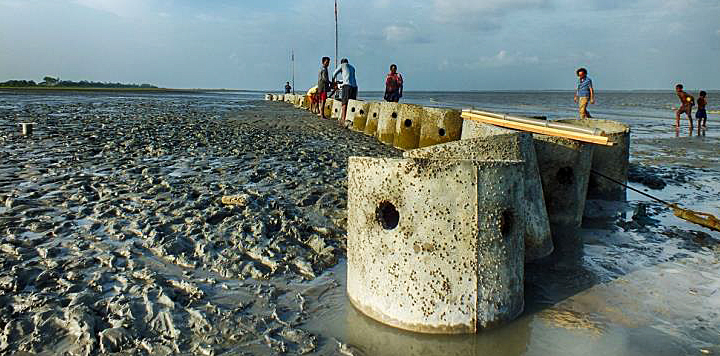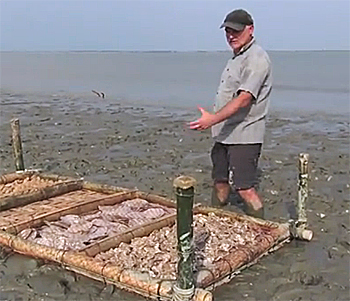Ecobas: Artificial oyster reefs can keep pace with sea level rise

Artificial oyster reefs can prevent coastal erosion and grow fast enough in height to keep pace with sea level rise. Additionally oyster reefs increases the biodiversity, providing shelter and substrate for fish and crab, creating a source of food for the local human population
These are two main outcomes of a two year Dutch pilot on the Kutubdia Island, Bangladesh. The pilot was part of the Ecological Engineering for Coastal Protection and Food Production (Ecobas) project that concluded in December 2014.
Imitation reef of concrete
Dutch and Bangladesh researchers used a concrete structure measuring 50 metres long and approximately 70 centimetres high to imitate a fully-grown oyster reef.
"This proved to be the best, technologically and financially. The oysters attached themselves to the hollow concrete structures, which also form a habitat for crabs and fish", says professor Tom Ysebaert of Dutch marine ecology research institute Imares. Ysebaert investigated the socio-economic possibilities of the artificial oyster reef.
 Tom Ysebaert at the start of the Ecobas project when the type of oysters was selected (also see video below).
Tom Ysebaert at the start of the Ecobas project when the type of oysters was selected (also see video below).
Well growing oysters
After one year there were large numbers of oysters, while the wave-dampening effects resulted in sediment being deposited behind the reef. "The oysters showed good growth. After one year we already had oysters measuring four centimetres", reveals Ysebaert.
According to calculations with models, the oyster reef could grow in height by about two centimetres per year. This will allow it to keep pace with the rising sea level.
Protection against tropical storm
But when a genuine tropical storm hits, an oyster reef is not enough. "'We expect that the mangrove forest will survive better and spread faster if there is an oyster reef present. In order to protect the coast, a strip of mature mangroves measuring at least 250 to 500 metres wide is needed", explains Ysebaert.
Self-reparing coastal defence
Not every sea floor location along the coast is suited for mangroves and oyster reefs. Ysebaert: "This method can be applied at a great many locations. It's impossibly expensive to construct concrete dikes everywhere, and the earthen dikes alone are often too vulnerable. This form of eco-engineering is sustainable, durable and relatively inexpensive. In the long term, it provides a self-repairing coastal defence system of oyster reefs and mangrove forests."
Participants in the Ecobas-project were engineering firm Royal HaskoningDHV, University of Chittagong and research institutes Imares (Institute for Marine Resources & Ecosystem Studies), LEI (Agricultural Economics Research Institute) of Wageningen University.
Follow-up research is currently taking place, and the Bangladeshi government is interested in larger pilot projects.
This news item was originally published on the website of Wageningen University/Ecobas.
Also read on this website
● Dutch consortium shows oyster reef potential for coastal defence and food production in Bangladesh, 4 December 2012
● Ecobas - Oyster reefs for sustainable coastal defense and aquatic food production
● Countries: Bangladesh
More information
Imares
Wageningen, the Netherlands
+31 317 487 419
www.wageningenur.nl/em/imares
LEI Wageningen UR
Wageningen, the Netherlands
+31 70 33583 63
www.wageningenur.nl/en/lei
Royal HaskoningDHV
Amersfoort, the Netherlands
+ 31 88 348 20
www.royalhaskoningdhv.com/en
Tom Ysebaert of Imares at the start of the pilot in 2012, explaining the selection of type of oyster.
Animation showing eco-engineering, starting with constructing an oster reef that eventually forms a natural barrier to break waves.



